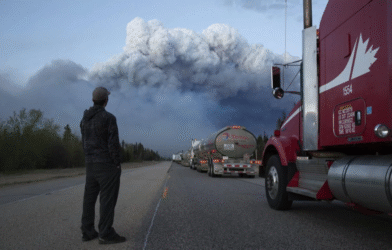Attached is a screen grab from my dash camera of load that struck a bridge in North Dakota yesterday. The drivers permit contained an error, and he didn’t catch it until his 15 ft high load dint make it under a 14 ft 10 in bridge.
We covered them before, but OD (over dimension) loads seem to be a hot topic again. OD loads come in all different shapes and sizes, and they are not limited to open deck trailers, though most do travel on open deck trailers. OD is anything that exceeds the industry standards regarding height, length, width and weight. All such loads generally require a permit for every state and province they travel through, and the permit requirements and restrictions vary from one jurisdiction to the next. So before starting your trip, make sure you have the permits in hand, and that you have read and understand every single requirement. Some places won’t even load you until you have all the needed permits. Carry a yellow highlighter to highlight the pertinent sections for easier reference. If you’re over width, then the requirements for over height and over length don’t really apply to you. Make sure the information regarding the load on the permits is accurate. For example, if your load is 15 ft high and the permit lists it as 14 ft 11 in, then the permit isn’t really worth the paper it’s written on. If the permit says you require one of more pilot vehicles, be sure to give a copy of the permit to the driver of each pilot vehicle. Is better to have 2, 3 or more people go over the permit(s)
The permit will describe your truck in detail (unit #, plate #, make, model, year, DOT #, VIN, & registered max weight, width, height and length) and list the details of the load. It will also have your detailed routing information, listed turn by turn as well as the allowable maximum weight, length, height and width. It will also list all the requirements (lights, flags and signs) and operating times along your route. For this reason, you MUST read and understand all the requirements of all your permits, as they can vary from one jurisdiction to the next. For example, travel is permitted in SK from 1/2 before sunrise to 1/2 after sunset 7 days a week for loads up to 4.1 metres wide. For loads over 4.1 metres wide, travel is prohibited after noon on Sunday. AB prohibits loads over 4.1 metres wide all day Sunday, and after specific times on certain holidays and holiday weekends. Some jurisdictions require pilot cars or police escorts for certain OD loads, others don’t. These are a few of the reasons why you need to read and understand the permit requirements.
Even if you do read and understand the permits and follow the approved routes, you can still find yourself in a bad situation. One driver, following his permit encountered trees overhanging his path and took it upon himself to prune the trees back to allow him to pass. The fine for that was over $10,000, and his argument that he was on the route on his permit held no water in court. Just yesterday a driver hit a bridge in Minot ND, due to an erroneous routing on his permit. Regardless of the permit says, the driver is still responsible to ensure safe travel over and under and through towns, and construction zones.















Comments are closed